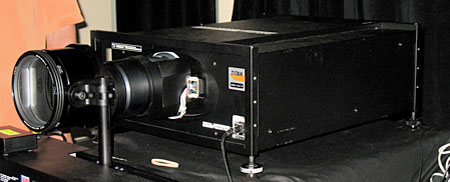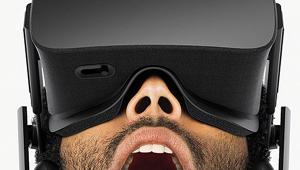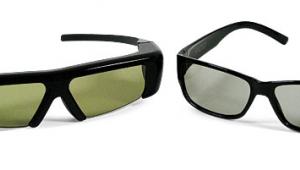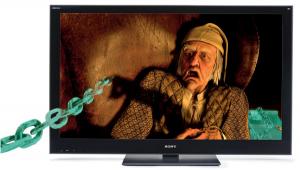Springing Toward 3D
The home 3D machine is shifting into overdrive. Both Sony and Panasonic have upcoming 3D launch events for the press scheduled during the second week of June.
Digital Projection, which manufactures a wide range of DLP projectors for both the home and professional market, recently participated, along with Stewart Filmscreen, S1 Digital (a manufacturer of media centers, soon to include playback for 3D Blu-ray), Crestron, and AV Partners in a 3D-centric event at the Stewart Filmscreen training facility near Los Angeles. The session was aimed primarily at dealers and custom installers.

The goal was to get them up to speed on 3D technology before the arrival of a (hoped-for) flood of contracts for big-screen 3D home installs and conversions. Given Digital Projection and Stewart's market, the emphasis here was on 3D front projection, not on flat panels.
Much of the basic information in the presentations will be familiar to readers who have digested the 3D articles in recent issues of Home Theater, including "3D: The Next Big Thing" (April 2010), the June first look at the first 3D display and 3D Blu-ray player to grace our pagesthe Samsung ULN46C8000 3D HDTV and BD-C6900 3D Blu-ray player and upcoming full reviews of that set (July 2009) and player (August 2009). I won't retrace that ground here.
But the talks also provided a lot of new and interesting information. Stewart Filmscreen was the first up to the plate, and as expected offered advice as to the best screens to use for a 3D projection installation. Many if not most 3D in commercial theaters use various forms of polarization, together with those ubiquitous polarized glasses, to separate the images for each eye. (The main exception to this is the Dolby 3D system, which separates the two eye images by a subtle shift in their color spectrum. This should not be confused with the old and crude anaglyph system, which produces major, visible color distortions.) But commercial theater screens (and home theaters screens as well) are typically diffusive. That is, they are designed to reflect light in all directions. But this diffusion destroys polarization, so theaters that use polarization for 3D must install a special, silvered screen.
The problem with silvered screens (apart from cost) is that they degrade 2D projection with hot spots and other artifacts. This rarely concerns most theater owners who happily use these converted theaters for both 2D and 3D films; they trust (sadly, correctly) that most of their audiences will be oblivious to the quality loss with 2D. For home theater, however, where the best quality for both 2D and 3D is (or should be) a major consideration, use of a polarized 3D system would mean the installation of two different screens. Since this is impractical for obvious reasons, the home 3D projection technique being promoted by Digital Projection, and likely to be championed by other projector manufacturers as well, uses shutter glassesthe same technology being used on 3D flat panel displays.
Because 3D entails a significant loss of brightness. Theatrical 3D currently provides a dim 4-5 foot-Lamberts of brightness, less than a third of the 2D digital cinema standard of 14 ft-L. Stewart recommends screens with a moderate amount of gain, including that old standby, the Studiotek 130 with a gain of 1.3.
Digital Projection's presentation, by the company's VP of Home Cinema, George Walter, provided the most new information. The firmware update that will allow the PlayStation 3 to play back 3D Blu-ray discs (or at least the movies themselves, there may still be issues with some menus and special features) is expected in June. Ditto the firmware to allow DirecTV to provide 3D service. 3D on cable, satellite, and over-the-air, however, will be interlaced and half-resolution for the foreseeable future. Put bluntly, it will be standard definition, not HD. It was also noted that projected 3D cannot, at present, be achieved with an anamorphic lens. But Digital Projection is working to solve this issue. In fact, one of the DP 3D demos did use an anamorphic lens, so they are obviously well along on a solution.
The IR signal needed to trigger 3D shutter glasses in a projection setup currently comes from a separate IR emitter that must be installed near the screen, much like the built in emitter in a flat panel 3D HDTV. To cover the audience in a larger than average home theater, however, more than one emitter is often needed. But that can interfere with IR receivers in other parts of the system. To get around this, Digital Projection is working on triggering the glasses via white pulses embedded into the image, a technique they call DLP Link. . The pulses will operate fast enough to be invisible to the eye.
Digital Projection also provided further clarification of the 3D polarization technique used in theatrical presentations. In order to provide full 2K (HD-level) resolution on the screen, a combination of both active and passive techniques are used. With a strictly passive system and polarized glasses, both left and right eye images are flashed on the screen at the same time, with each of the images using half of the projector's 2K resolution. Therefore each eye would see a half-resolution image—that is (to use video terminology), standard definition. But if we then place a polarizing shutter in front of the projection lens, and trigger it in a way that the separate eye images are flashed sequentially rather than together, each with alternating polarization and with polarized glasses to sort them out for the viewer, the resolution of the images that reach each eye can be a full 2K. While you can achieve the same result with active shutter glasses alone (and no polarization), that's impractical in a theatrical venue because of the cost; each theater would need to purchase and maintain hundreds of expensive shutter glasses. The Active-Passive technique is impractical for the home because it still requires a silvered screen for 3D (thus a need for separate 2D and 3D screens). And more importantly, it is not usable with flat panels (the bulk of the potential 3D market) because the separate polarizing shutter must be placed in front of a projection lens.
Digital Projection had five projectors set up and offered compelling demonstrations on each of them. Two of the demos were 3D. But while my initial impression was less than eye-popping when they showed a short scenic clip of the Grand Canyon, I later learned that this particular piece was actually half-resolution 3D. This did not inspire confidence in what we can expect to see from 3D over satellite, cable, and over-the-air, but the losses may well be less visible on a small flat panel.
But the high definition 3D presentations, on both the big Digital Projection Lightening projector (on 13-foot wide Studiotek 130 screen) and slightly smaller (but hardly tiny) Titan (14-foot ST130), were uniformly stunning. Digital Projection insists that the full impact of 3D can be had only on a really big screen. And while my initial experiences with smaller flat panel 3D have been positive, I can't say I disagree.
- Log in or register to post comments












































